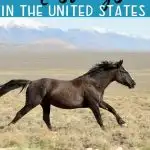When you hear the term “mustang horse” in the United States, did you know that could refer to a variety of different groups of horses? In fact, the term “mustang” has become a kind of catch-all for any feral or even grade horse. There are many types of mustangs roaming wild in the United States. Let’s have a look at them.
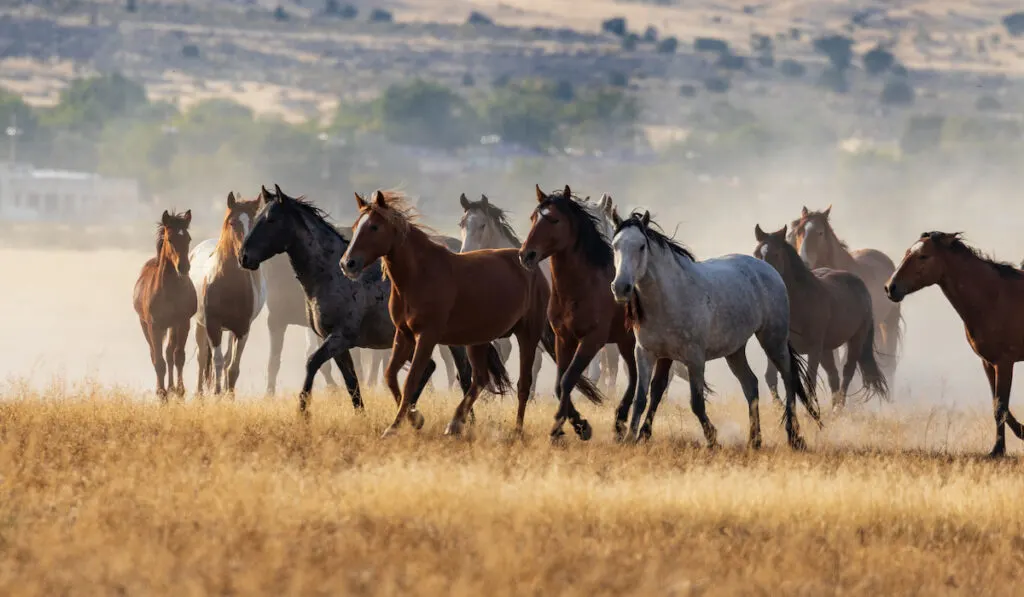
Table of Contents
BLM Mustangs
BLM Mustangs are managed by the Bureau of Land Management (BLM). They are the horses that roam in federally protected herd management areas in the western United States.
In fact, BLM horses roam wild in Arizona, California, Colorado, Idaho, Montana Nevada, New Mexico, Oregon, Washington, Utah and Wyoming.
BLM monitors the health of the herd and population levels and occasionally rounds up areas in order to restore balance. These horses are then offered for adoption to the public.
ALL BLM mustangs have a unique BLM brand placed on the left side of their neck. This brand consists of symbols which can be translated to numbers.
This brand is the horse’s official government ID and can be looked up by BLM officials if a mustang’s paperwork becomes lost. If you want more information, check out this post on how to decode a BLM mustang brand.
There are various programs in place to encourage mustang adoptions. You can adopt trained horses through the TIP program, prison programs and various mustang makeover events. Additionally, the BLM offers a $1,000 incentive for adopting wild mustangs.
I have more details about the BLM adoption process on my post: BLM Wild Mustang Adoption.
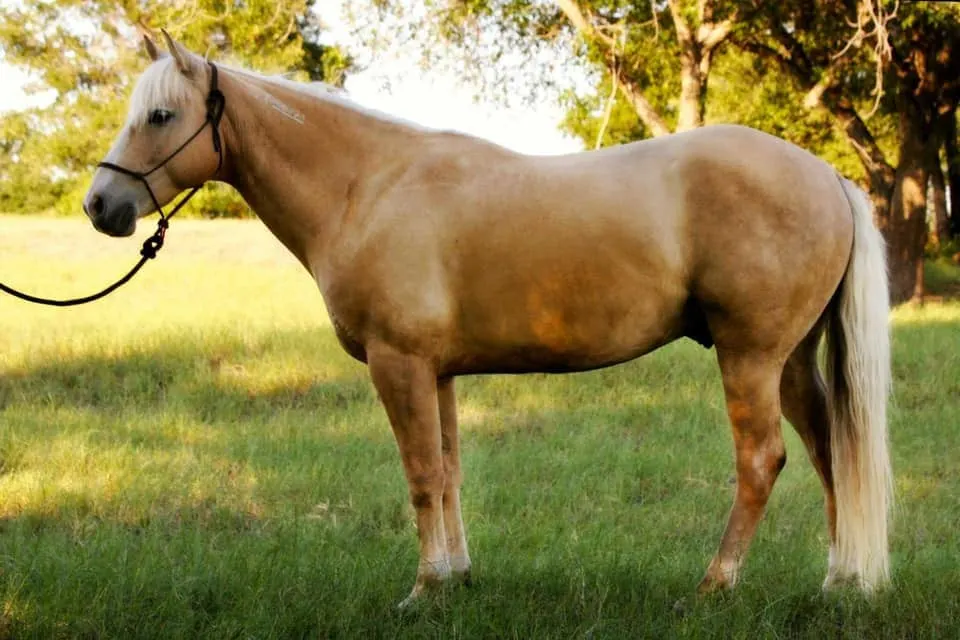
Kiger Mustangs
Columbus returned to the Americas in 1493. He intended to bring some fine Andalusian horses with him, but his men had sold them for some cheap Sorraia horses instead. These scrappy animals were typically a dun color, and many had zebra-like markings and an ambling gait. In 1977, a unique group of mustangs was discovered from the Kiger region of southwestern Oregon.
These horses had been insulated from the intermixing of heavier cavalry horses in the 1800’s, and DNA testing confirmed that these horses were genetically linked to the early Andalusian and Sorraian horses.
These mustangs are usually lighter in color, ranging from dun to cremello, and have a specific Spanish-type appearance with a Barb head. A Kiger mustang was the inspiration for the children’s film Spirit, Stallion of the Cimarron. (Dutson, 1996)
Pryor Mountain Mustang
In the Pryor Mountains of Montana, a select group of mustangs roams in the National Wild Horse Refuge. They are considered to be the “purest” mustangs – those most closely linked genetically to the original Spanish horses.
Pryor Mountain Mustangs are known for their endurance, ruggedness, and high knee action. According to the Pryor Wild Mountain Mustang Center, they typically are around 14 hands high. These horses are very graceful and athletic, and are often gaited as well.
Forest Service Mustangs
When the Wild Free-Roaming Horses and Burros Act was passed in 1971, some areas were managed by BLM and some were in the care of the Forest Service. The US Forest Service is also responsible for managing wild horses on their land.
The U.S. Forest Service is a federal entity just like the BLM but their budgets for their respective wild horse and burro programs are different.
The U.S. Forest Service does not have a well developed capacity for managing wild horses as the BLM and, as such, typically partners with them to assist in gathering wild horses, processing them for adoption and finding homes.
The U.S. Forest Service also gets a lot of support from private individuals who spend their private time trying to make sure that every horse gathered finds a home.
Devil’s Garden Mustangs
In 2018, the Devil’s Garden mustang herd was gathered. The last horse was gathered in November with the final count being 932.
Advocates created Facebook pages to help network and find these horse adoptive homes. Of particular concern were the 255 horses over 10 years of age that were not transferred from the Forest Service to BLM care. These horses were, instead, to be sold to the highest bidder.
Thankfully, much like the BLM, the Forest Service does have a strict contract in place which prohibits purchased horses from being treated cruelly, neglected or sold for slaughter.
Spearheaded by horse lovers and wild horse advocates, the Devil’s Garden Wild Horse Emergency Rescue Facebook Page worked to network homes. As of August 2019, the page reported all 255 horses from the 2018 gather have found private homes.
The US Forest Service ensured that all gathered animals were micro-chipped. Additionally, the Devils Garden horses placed into BLM care were all branded by the BLM.
Check out the Devil’s Garden Wild Horses blog to learn more about the Devil’s Garden mustang, including the Fall 2018 gather, from the perspective of a US Forest Service intern.
If you are currently looking to adopt a wild mustang and want a horse from the Devil’s Garden gather, contact the BLM at 866-468-7826 or email [email protected].
Another gather is planned for Devil’s Garden in September of 2019. Up to date information about this gather can be obtained from the U.S. Forest Service website.
Various Facebook groups will continue to advocate and network adoptive homes for the 2019 gather of Devil’s Garden mustangs. Here are a few you can follow:
- Devil’s Garden Wild Horse Emergency Rescue
- Double Devil Wild Horse Corrals
- Devil’s Garden Wild Horses
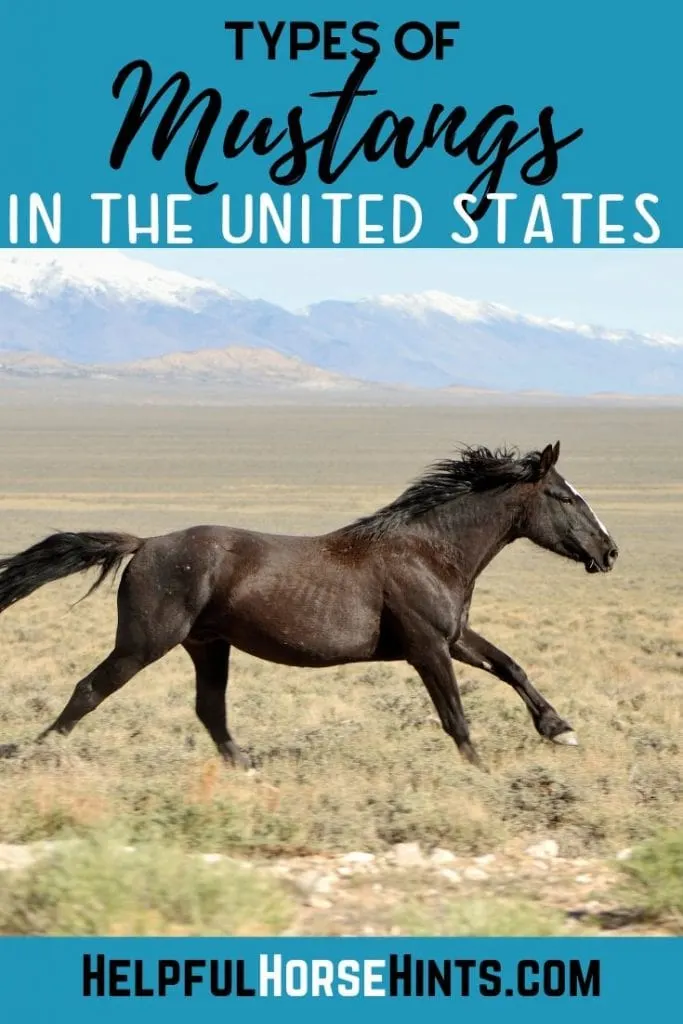
State-Owned Mustangs
There are wild horses that also roam in various states across the United States. These horse populations are managed by the state in which they roam. Each band of horses is typically named for the area in which it roams. Let’s look at some of the wild horses managed by individual states.
Virginia Range Wild Horses
As of 2014, there were almost 2,000 wild horses roaming the Virginia Range in Nevada. Though these horses live in Nevada, the state with the largest BLM mustang population, these horses did not live on BLM land and so did not get the federal protections afforded to other wild horse herds in the state.
Of course, their geographic location doesn’t mean that they were in any less need of management and adoptive homes. The Nevada Department of Agriculture is, instead, responsible for managing their population and finding homes for excess animals removed from the range.
While the Nevada Department of Agriculture can legally sell the excess wild horses at public auction, they have had an agreement with the American Wild Horse Campaign up until 2017 to ensure that quality adoptive homes are found for removed animals. (source)
After the agreement was terminated with the AWHPC in 2017 the state of Nevada began looking for a new organization to help with the management of the horses in the area. (source)
Salt River Wild Horses
In the banks of the Lower Salt River in the Tonto National Forest in the state of Arizona, you might find wild horses. The horses that roam here are called the Salt River Wild Horses.
The Salt River Wild Horses have roamed the area for well over a century. They are believed to be descended from Spanish horses brought to Arizona in the 1600s.
As of 2017, the US Forest Service estimated a little over 400 horses were in the area however there is some disagreement from organizations who feel the USFS overestimated by at least double. (source)
For many years, the United States Forest Service claimed these horses were stray livestock rather than wild horses. In 2015 the Forest Service threated to “impound” the animals because neither the state of Arizona nor the surrounding Native American tribes would claim responsibility for them. (source)
In 2016 the Salt River Wild Horse Act was introduced and signed into law that same year. This law confirmed the wild horses were not stray livestock and formed a pathway for the management of the herd.
While numbers may need to be reduced in the future to prevent overgrazing, the state of Arizona and the National Forest Service are still working on a management plan for these animals. In the meantime, they roam free.
National Park Service Mustangs
The more places you look in America the more you realize how integral wild horses to our country. In this section, we’ll look at the wild horses under the care of the National Park Service.
North Dakota Badlands Horses
The Theodore Roosevelt National Park is located in North Dakota. The feral horses living there are managed by the National Park via roundups every three to four years. Bait trapping is also used with some success as well.
The park works with two different non-profit organizations to help effectively manage the wild horse populations. These are the North Dakota Badlands Horse and Wild in North Dakota. The last gather of the horses in Theodore Roosevelt National Park was 2018. (source)
Assateague and Chincoteague Wild Horses
The wild horses on Assateague island have been made famous by writer Marguerite Henry, among others. Legend suggests these animals first arrived at the island as part of a shipwreck, however, there is no historical evidence to prove that.
The island lies on a borderline for the states of Virginia and Maryland. As such, the wild horse population is managed by two different organizations.
The National Park Service manages horses on the Maryland side while the Chincoteague Volunteer Fire Company manages the horses on the Virginia side of the island. A fence separates the two sides.
Gathering of the Assateague horses is unique in that the horses are rounded up and must swim from Assateague Island to Chincoteague Island. There, the young foals are auctioned off and the remaining horses are returned. The proceeds benefit the Chincoteague Volunteer Fire Department. This gather is held once a year on the last Wednesday in July. (source)
Shackleford Banker Ponies
Off of the outer banks of North Carolina, herds of wild ponies roam Shackleford Island. Their official origin is unknown, but it’s possible that they were abandoned by fleeing Spanish colonizers.
These ponies are managed though a joint effort by the state of North Carolina and the National Park Service. As part of the Shackleford Banks Wild Horses Protection Act, a non-profit organization also assists with their management. (source)
Like the ponies of Chincoteague and Assateague, the Shackleford Banker Ponies have adapted to their environment, digging for fresh water and surviving off of poor quality salty grasses.
Mustangs on Tribal Lands
Wild horses can also be found on tribal lands. These lands, owned by various Native American tribes, support tens of thousands of wild horses.
Unlike the federally managed herds, mustangs on tribal lands have no protections from slaughter. They are not part of the Wild Free-Roaming Horses and Burros Act.
Unlike the federally managed horses, the horses found on tribal lands are typically referred to as feral horses and not mustangs. These horses are considered the private property of the tribes on whose land they reside. As such, it is the tribes responsibility to choose to gather them or not.
Wild, or feral, horses on tribal lands are not branded with the same Alpha Angle symbols as BLM horses. They may be given other types of brands for identification at the tribes discretion.
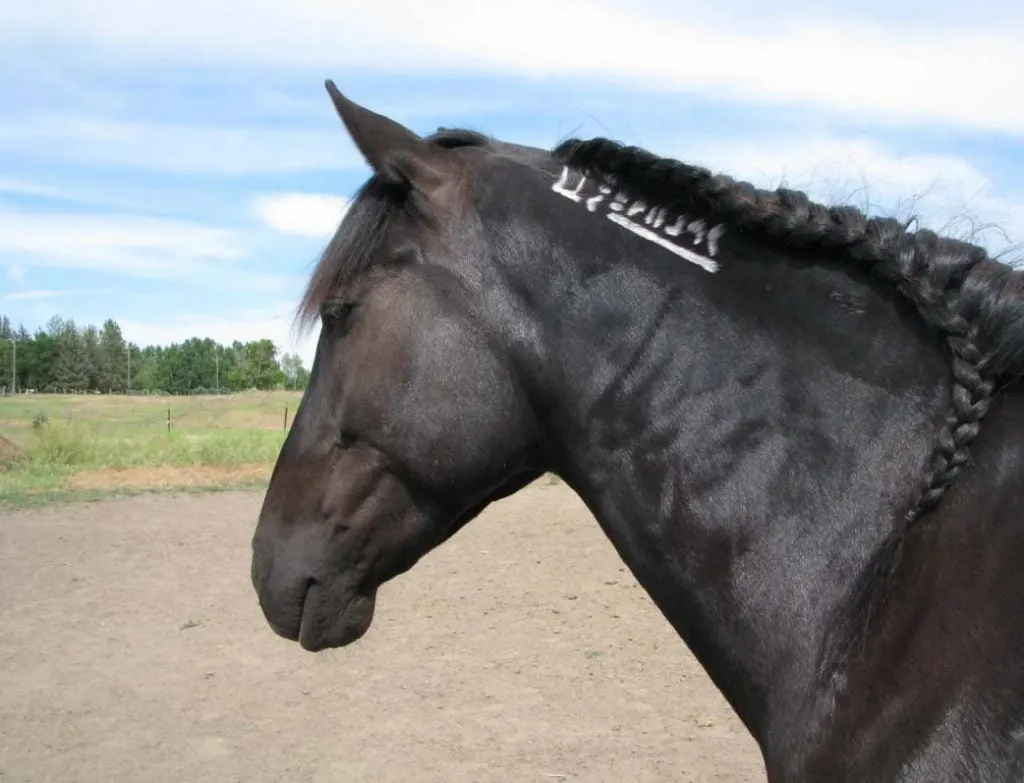
While I know quite a bit about the BLM program through personal experience, I don’t truly know a lot about the tribal mustangs. I found this article, by High Country News, particularly informative on the subject.
Captive Foaled Mustangs
When wild horses are gathered, most of the females will have a foal at side or be pregnant, sometimes both. These babies are all bred in the wild but, the foals of mares who are gathered pregnant, will be born in captivity.
These foals are no less mustangs. They still share the same genetics and heritage as any wild born mustang. In the case of BLM and Forest Service horses, they, however, have never known thirst or hunger.
Foals born in the wild horse holding corrals will still receive brands before being adopted. In some cases, the mares find new homes while still pregnant. These foals, born in their mother’s adoptive homes, will not be branded by the BLM. They are still mustangs.
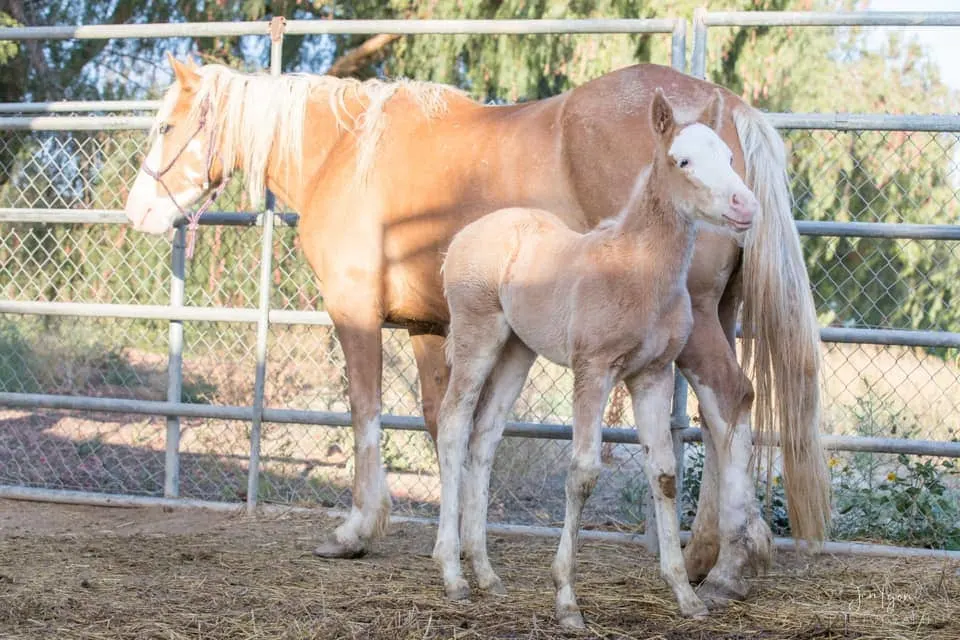
Captive Bred Mustangs
Captive foaled and captive bred are two distinctly separate things. Once a horse is adopted, the owner can breed the horse as he/she desires. In fact, the Private Care and Maintenance Agreement has no exclusions for breeding.
Some types of mustangs, such as those located in the South Steens, are highly prized by mustang enthusiasts. They most famous of which are the Kiger mustangs. As such, registries have been established to track the bloodlines of captive animals who are bred.
Additionally, some mustangs may possess desirable traits. Some wild mustangs have the curly gene, for example, which creates a hypoallergenic horse.
The BLM does geld (neuter) most male horses but the sterilization process for mares is not as simple. The decision whether or not to breed adopted mustangs is, and will continue to be, the choice of the adopter.
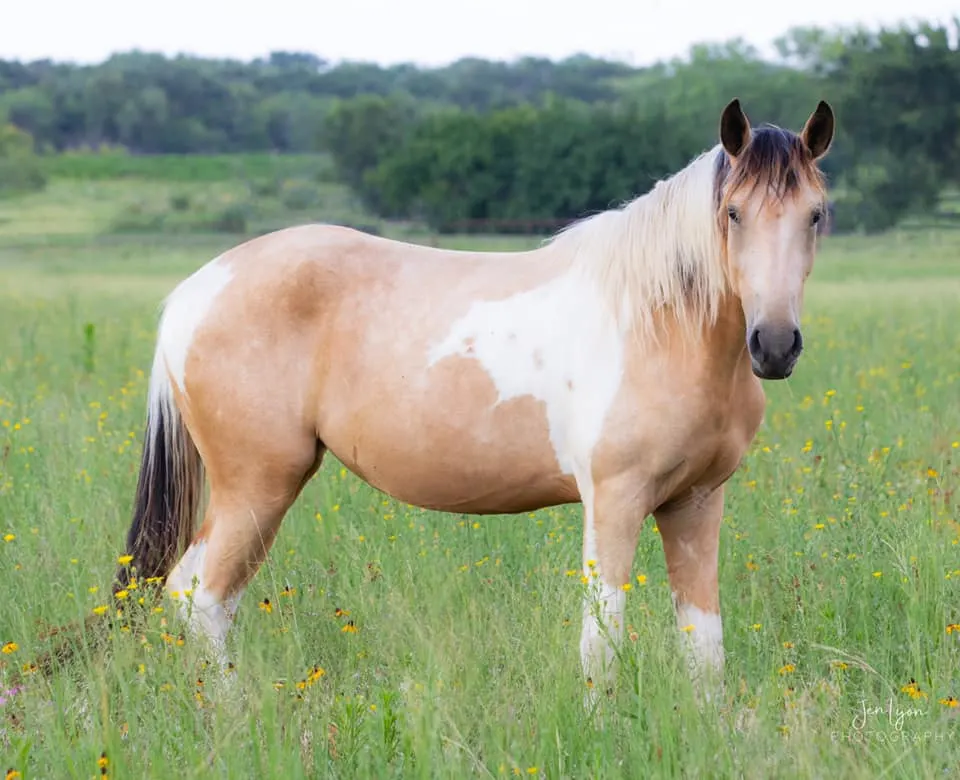
Are these horses still mustangs? I guess it depends entirely on your viewpoint. In the case of the Kiger mustangs, the herd is naturally isolated and inbred so, it stands to reason, that if members of the same herd are bred together, the resulting foal is still a mustang.
On the other hand, when you start mixing BLM mustangs from different herd areas that would never naturally come into contact with each other, that line between mustang and non-mustang gets more fuzzy.
Clearly, though, a foal that is the result of crossing a BLM mustang with any other domestic bred horse (purebred or grade) is no longer a mustang. That foal would be either a grade horse or possibly registered as a half-something (i.e. Half-Arabian, Half-Andalusian, and so on).
Grade Horses
“Grade” is a term typically used to refer to a horse with no known pedigree. It can also be used to describe any horse without registration papers of unknown or questionable ancestry.
A grade horse is usually not a mustang though, by definition, all mustangs are grade horses. If you purchase a horse with no documentation, it is likely a grade horse and not a mustang even if the person you bought it from is a mustang.
The only true way to know if you have a mustang or not is if you have documentation (for a captive foaled horse), or if the horse has a microchip or freeze brand that can be traced. If you know that one parent is mustang, typically the horse would be referred to as a “Grade Mustang” or “Half Mustang”.
A breed qualifier is often used for grade horses that resemble a certain breed but with no evidence to back it up, like the “Grade Quarter Horse” pictured below. A “Grade Mustang” could also be any horse with no pedigree that doesn’t really look like any type of registered horse.
Mustang or not, it doesn’t mean your horse is any less special. It is just a different form of terminology. In fact, since horses aren’t native to North America, most American Horse Breeds (see my list of popular American horse breeds here) were founded from grade mustangs that were selectively bred for certain traits.
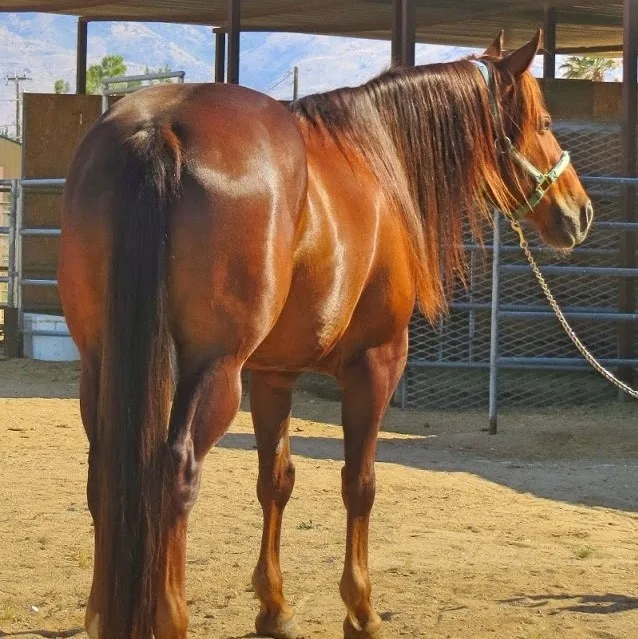
Final Thoughts
The American mustang is an integral part of the American West. Mustangs have been transformed into an American icon due to their integral role in the American west. The Wild Free-Roaming Horses and Burros act of 1971 defined certain areas of federal lands as protected areas for mustangs.
While wild horses do roam areas outside of these federally designated areas, the horses contained within are classically defined as “mustangs”. For horses with unknown origin, who can’t be traced back to federally managed lands, the correct terminology to describe the horse is “grade” and not “mustang”.
Related Posts
- Wild Mustang and Burro Training Equipment
- Surviving Wild: Diet of the American Mustang
- 7 FAQ’s About Selling a BLM Mustang
Source:
- https://www.devilsgardenwildhorses.com/blog/freedom-isn-t-free

